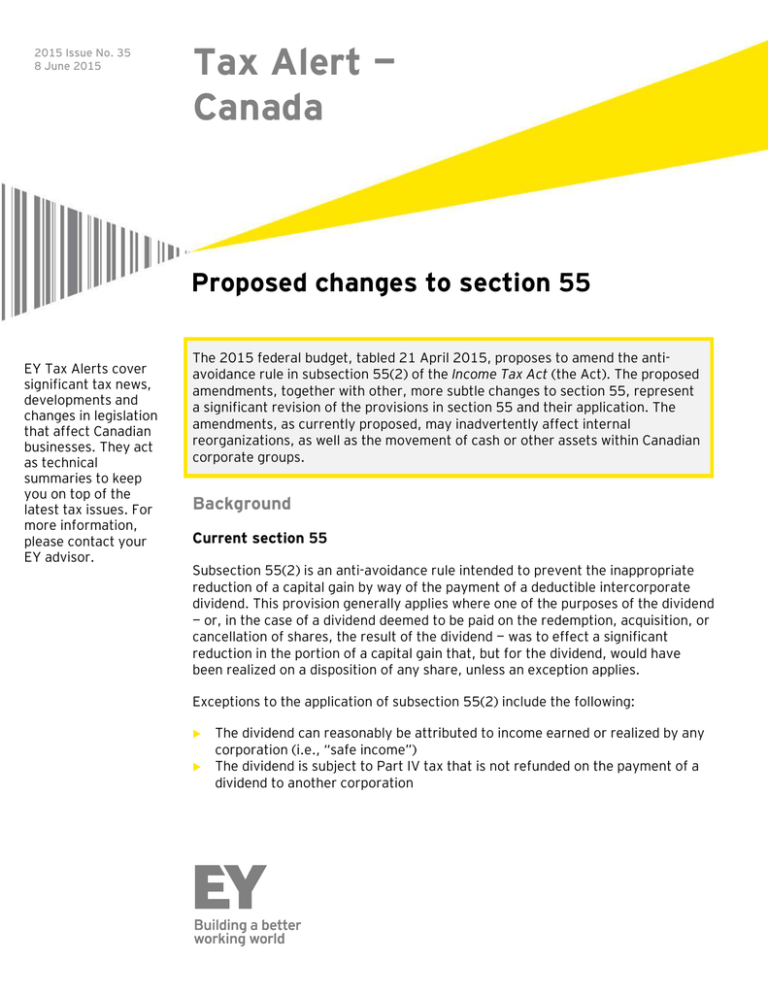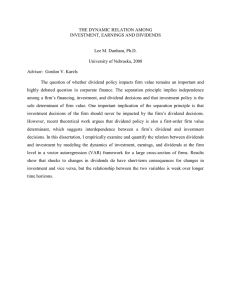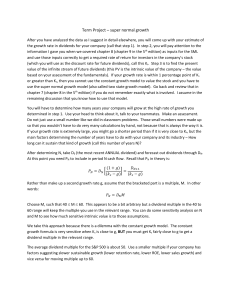
2015 Issue No. 35
8 June 2015
Tax Alert —
Canada
Proposed changes to section 55
EY Tax Alerts cover
significant tax news,
developments and
changes in legislation
that affect Canadian
businesses. They act
as technical
summaries to keep
you on top of the
latest tax issues. For
more information,
please contact your
EY advisor.
The 2015 federal budget, tabled 21 April 2015, proposes to amend the antiavoidance rule in subsection 55(2) of the Income Tax Act (the Act). The proposed
amendments, together with other, more subtle changes to section 55, represent
a significant revision of the provisions in section 55 and their application. The
amendments, as currently proposed, may inadvertently affect internal
reorganizations, as well as the movement of cash or other assets within Canadian
corporate groups.
Background
Current section 55
Subsection 55(2) is an anti-avoidance rule intended to prevent the inappropriate
reduction of a capital gain by way of the payment of a deductible intercorporate
dividend. This provision generally applies where one of the purposes of the dividend
— or, in the case of a dividend deemed to be paid on the redemption, acquisition, or
cancellation of shares, the result of the dividend — was to effect a significant
reduction in the portion of a capital gain that, but for the dividend, would have
been realized on a disposition of any share, unless an exception applies.
Exceptions to the application of subsection 55(2) include the following:
The dividend can reasonably be attributed to income earned or realized by any
corporation (i.e., “safe income”)
The dividend is subject to Part IV tax that is not refunded on the payment of a
dividend to another corporation
The dividend is received as part of certain
related party transactions (the 55(3)(a)
exception) or a qualifying butterfly
transaction (the 55(3)(b) exception)
If subsection 55(2) applies, the dividend is
deemed not to be a dividend, and is treated as
either proceeds of disposition of the share
(where the share has been disposed of) or as a
gain for the year from the disposition of capital
property (where the share has not been
disposed of).
that actually reduces a capital gain on any
share).
Rationale for proposed changes
Subsection 55(2) does not currently apply to
dividends that create or increase an unrealized
capital loss on a share. In this circumstance, a
shareholder may have been able to use such an
unrealized loss that arose as a result of paying
dividends on a share of a corporation to
effectively shelter a capital gain on another
property. In this type of situation, the accrued
loss on the share could be utilized where a
property on which there is an accrued gain is
transferred to the corporation before a sale of
the “loss” shares. The stop-loss rule in subsection
112(3) would not apply in these circumstances if,
in fact, no loss is realized on a disposition of the
loss shares. This, combined with the recent Tax
Court of Canada decision in D&D Livestock Ltd. v
The Queen (2013 DTC 1251 (TCC)), appears to
be the government’s main motivation in
introducing significant changes to the application
and scope of section 55.
Proposed changes to section 55
Proposed amendments to section 55 contained
in Budget 2015 that are of particular
significance include the following:
Subsection 55(2) would apply where one of
the purposes of the payment or receipt of
the dividend is to effect a significant
reduction in the fair market value of any
share, or a significant increase in the total of
the cost amounts of all properties of the
dividend recipient (regardless of whether the
dividend is part of a series of transactions
Subsection 55(2) could potentially apply
where the value of the relevant share prior to
the dividend payment is nominal.
Special rules would apply in respect of stock
dividends to ensure that the full fair market
value of the stock dividend shares, rather
than only the amount of their paid-up capital
(PUC), is subject to the provisions of
subsection 55(2).
Any dividend to which subsection 55(2)
applies would be treated as a gain from the
disposition of capital property (i.e., the
concept of adding the amount of the dividend
to proceeds of disposition where a share is
disposed of would no longer apply).
The 55(3)(a) exception for certain related
party transactions would be restricted to
deemed dividends received as a result of the
redemption, acquisition or cancellation of
shares by a corporation (i.e., the related
party exception found in paragraph 55(3)(a)
would no longer apply to regular cash or inkind dividends paid, or to subsection 84(2)
dividends).
The amendments are proposed to apply to
dividends received by a corporation on or after
21 April 2015. This in itself creates some
uncertainty, as the Department of Finance has
indicated that additional consequential changes
to the Act may be required, but has not yet
specified the nature of these changes.
Analysis
Potential implications of the proposed
changes
The proposed amendments represent a significant
revision of the provisions in section 55, and their
application. The amendments, as currently
proposed, may inadvertently affect internal
reorganizations, as well as the movement of cash
or other assets within Canadian corporate groups.
Proposed changes to section 55
|
2
More particularly, below are examples of common
scenarios where the proposed amendments to
section 55 may preclude a dividend received by a
corporation from being deductible and result in its
recharacterization as a capital gain. The extent to
which it is intended that proposed subsection
55(2) should apply to these situations is currently
unclear, and corporations should be mindful of
them as we await further guidance from Finance.
Payment of regular periodic dividends
Many public and private companies have a
practice of making periodic distributions to their
shareholders by way of regular (e.g., annual)
cash dividend payments. Under existing
legislation, it is generally possible for a
corporate dividend recipient to rely on the fact
that the purpose of such a dividend is not to
reduce a gain on a share, or to rely on the
exception found in paragraph 55(3)(a) if, as a
factual matter, the dividend was not attributable
to safe income. As Budget 2015 proposes to
amend the 55(3)(a) exception such that it
applies only to deemed dividends arising on the
redemption, acquisition or cancellation of
shares by a corporation, this particular
exception would not be available in respect of
any other taxable dividends received by a
corporation that is entitled to the intercorporate
dividend deduction. Consequently, corporate
shareholders may need to place an increased
reliance on the safe income exception. This may
necessitate dividend-paying corporations to
maintain up-to-date safe income calculations so
as to provide comfort to corporate shareholders
that the safe income exception is available
(rather than completing safe income
calculations only in advance of an anticipated
sale of shares).
Alternatively, corporate shareholders may need
to rely more heavily on the “purpose test”
exception in proposed subsection 55(2). Under
the proposed amendments, one of the purposes
of the dividend cannot be to reduce a capital
gain on a share, the fair market value of a
share, or increase the total of the cost amounts
of all properties held by the dividend recipient.
All dividend payments would likely be
considered, as a practical matter, to reduce the
fair market value of a share of the capital stock
of the dividend payer (unless the share has nil
fair market value) or increase the total of the
cost amounts of all properties held by the
dividend recipient. However, based on a textual,
contextual and purposive interpretation of the
proposed rules, it may be reasonable to conclude
that the purpose of regular periodic dividend
payments is to provide a return to shareholders,
and not to effect a significant reduction in the
fair market value of any share or a significant
increase of the total of the cost amounts of all
properties held by the dividend recipient.
The purpose test exception found in the
proposed amendments, which provides less
certainty than the existing 55(3)(a) exception
and the safe income exception, will need to be
relied upon with increased regularity if the
proposed amendments to section 55, as
currently drafted, are enacted. Corporate
taxpayers will need to consider how to
demonstrate to the Canada Revenue Agency
(CRA) the purpose of the payment or receipt of
an intercorporate dividend so as to ensure the
amended anti-avoidance provision in subsection
55(2) does not apply.
Payment of dividends as part of an internal
reorganization
The existing 55(3)(a) exception is generally
relied upon in various internal reorganizations
that may involve the payment of dividends as
part of certain related party transactions. As
discussed above, under the proposed rules, the
55(3)(a) exception would apply only to deemed
dividends arising on a redemption, acquisition or
cancellation of shares. Where this exception is
not available, the safe income exception or the
purpose test exception would need to be relied
upon. Where possible, in situations where the
safe income exception is not available, it may be
advisable for the parties undertaking the internal
reorganization to consider structuring any
contemplated dividends as deemed dividends
arising on the redemption, acquisition or
cancellation of a corporation’s shares, to ensure
that the 55(3)(a) exception is available.
Proposed changes to section 55 |
3
However, structuring the transaction in such a
manner will preclude the dividend recipient from
relying on the purpose test exception in the
event the 55(3)(a) exception is later determined
to be inapplicable.
Asset protection planning
Corporations often pay dividends to a corporate
shareholder consisting of cash in excess of that
required to operate the corporation’s business as
a means of protecting assets from future
business risks. As described above, the 55(3)(a)
exception would not be available under the
proposed rules, unless the distribution is
completed by way of a redemption, acquisition or
cancellation of shares by the corporation. Given
that, in such situations, dividends would likely
reduce the fair market value of the shares of the
dividend payer or increase the total of the cost
amounts of all properties of the dividend
recipient, one will need to conclude that the
purpose of the dividend payment or receipt is not
to effect a significant reduction in the fair market
value of the corporation’s shares or a significant
increase in the total of the cost amounts of all
properties of the dividend recipient.
Consequently, it may be advisable in such
situations to rely on the safe income exception.
Going forward, it may be more difficult to
undertake asset protection planning involving
dividend payments, unless structured as a share
redemption, if there is insufficient safe income to
support the amount of the dividend.
Loss utilization structures
In certain corporate groups, there may be one
or more corporations that have incurred losses
for tax purposes (Losscos), while other
corporations in the group have been profitable
(Profitcos). In these situations, loss utilization
structures are often implemented that allow for
the losses of the Losscos to be “transferred” to
and utilized by the Profitcos. These structures
typically involve, among other things, an
investment by the Profitco in preferred shares
of the Lossco having an entitlement to periodic
dividends equal to a percentage of the
redemption amount of the shares. The preferred
shares are normally redeemed on the unwinding
of the structure.
The CRA generally extends favourable income
tax rulings to taxpayers intending to implement
loss utilization structures, provided certain
conditions are met. With respect to the
deductibility of dividends paid as part of these
structures, the CRA has ruled that subsection
55(2) would not apply to the dividends because
the 55(3)(a) exception would be met.
Under the proposed amendments to section 55,
the 55(3)(a) exception would no longer be
available unless the structure in question
involves paying dividends by way of a
redemption, acquisition or cancellation of the
preferred shares, rather than paying cash
dividends. This presents another situation where
taxpayers may have to rely on the purpose test
exception (i.e., that the payment or receipt of
the dividend is solely to effect the loss utilization
arrangement, and not to reduce the fair market
value of any share or to increase the total of the
cost amounts of all properties of the dividend
recipient). It should be reasonable to argue that
the purpose of the payment or receipt of a cash
dividend on preferred shares issued in the
context of a loss utilization structure is to
provide a return on the preferred shares to the
dividend recipient, and to fund the interest
payable by the dividend recipient. We understand
that it was not the government’s intention to
thwart taxpayers’ ability to implement loss
utilization plans, especially given the CRA’s
practice of providing favourable rulings, and its
affirmation of the acceptability of loss utilization
structures in the recently issued Income Tax
Folio addressing interest deductibility. In the
absence of guidance from Finance, corporate
taxpayers must consider whether subsection
55(2) applies to loss utilization structures under
the proposed rules.
Possible double taxation on share redemptions
Where a corporation redeems — or acquires or
cancels — shares of its capital stock, the amount
by which the redemption proceeds exceed the
PUC of the shares represents a deemed dividend
paid by the corporation to the holder of the
Proposed changes to section 55 |
4
shares. In general terms, under the current
rules, the intended effect of the application of
subsection 55(2) is to ultimately ensure that the
dividend recipient realizes a capital gain equal
to what would normally have been such capital
gain had the dividend recipient sold the shares.
Under the proposed amendments, if subsection
55(2) applies, the amount of the deemed
dividend would be deemed to be a capital gain of
the dividend recipient from the disposition of a
capital property, without taking into account the
adjusted cost base (ACB) of such shares (which
would have otherwise reduced the gain had the
shares been sold rather than redeemed). In
addition, as a result of the disposition of the
shares, another capital gain would arise on such
disposition, unless consequential amendments
to other provisions of the Act are made. Even if
consequential amendments are introduced to
address the double taxation issue, taking into
account the current stop-loss rules (in
subsections 40(3.6) and 112(3)), any capital
loss triggered on the redemption may be
suspended to a later date, or denied. This could
result in a greater gain being realized by virtue
of the application of 55(2) than if the dividend
taxpayer had sold the shares.
These consequences may not have been
intended. In the Supplementary Information
accompanying the budget documents, it was
noted that further consequential amendments
to other provisions in the Act would be required
as a result of the implementation of the
proposed changes to section 55. It is unclear at
this time whether these consequential
amendments will fully address the
aforementioned issues.
Other considerations
Safe income exception where there is no gain on
a share – Existing subsection 55(2) does not apply
where there is no accrued gain on any share
before a dividend is paid. Under the proposed
amendments, subsection 55(2) can deem a capital
gain to be realized even where there is no accrued
gain on a share. In addition, the safe income
exception would be available only where the safe
income on a share could reasonably be regarded
to contribute to a capital gain on the share. Where
there is no accrued gain on the share, it appears
that the safe income exception would not be
available. It is our view that a corporate taxpayer
should be permitted to reduce the potential
deemed capital gain on a share under these
circumstances either with safe income, or by
utilizing existing cost base.
Part IV tax exception – Existing subsection
55(2) does not apply to a dividend where Part IV
tax is payable on the dividend, provided the Part
IV tax is not refunded on the payment of a
dividend to a corporation (i.e., the exception is
available where the Part IV tax is refunded on the
payment of a dividend to an individual or trust).
The proposed amendments modify the wording
of the subsection 55(2) such that the Part IV tax
exception is not available where Part IV tax is
refunded, as part of the series of transactions
that includes the dividend, on the payment of a
dividend by a corporation (which, presumably,
includes all dividends that result in the refund of
Part IV tax). It is currently unclear if it is the
government’s intention to not allow the
application of the Part IV tax exception where
Part IV tax is refunded as part of the particular
series of transactions.
Timing issue re: availability of capital dividend
account (CDA) balance – Under the proposed
amendments, any dividend recharacterized under
subsection 55(2) is deemed to be a capital gain for
the year in which the dividend is received. It is not
clear when the non-taxable portion of the deemed
capital gain is added to the corporation’s CDA
(i.e., at the time of the dividend? after the
taxation year end for the year in which the capital
gain is realized?). From a tax policy perspective,
the CDA should be available at the time of the
event giving rise to the capital gain that is
included in income for tax purposes.
Status of the proposed changes
The 21 April 2015 budget documents included a
draft Notice of Ways and Means motion and the
Supplementary Information. The first 2015
budget bill, Bill C-59, did not include the section
55 amendments. The Joint Committee on
Proposed changes to section 55 |
5
Taxation of the Canadian Bar Association and
Chartered Professional Accountants of Canada
submitted comments on the proposed
amendments to Finance on 27 May 2015.
Finance is currently considering this submission.
Are you contemplating the payment
of an intercorporate dividend?
A detailed technical analysis of all of the
proposed changes to section 55, and a
comprehensive summary of the many scenarios
that could be impacted by the proposed
changes, are beyond the scope this Tax Alert.
Corporations contemplating the payment of
intercorporate dividends, or transactions such
as share redemptions that could result in
deemed dividends for tax purposes, should
contact their EY or Couzin Taylor advisor, or
one of the professionals listed below, to
consider whether the dividend payments may
have unforeseen tax consequences under the
proposed changes to section 55.
Learn more
Quebec and Atlantic Canada
Christian Desjardins
+1 514 879 3551 | christian.desjardins@ca.ey.com
Alain Leonard
+1 514 874 4363 | alain.leonard@ca.ey.com
Andre Lortie
+1 514 879 6686 | andre.lortie@ca.ey.com
Prairies
Doron Barkai
+1 403 206 5209 | doron.barkai@ca.ey.com
Warren Pashkowich
+1 403 206 5168 | warren.w.pashkowich@ca.ey.com
Vancouver
Elise Rees
+ 1 604 643 5420 | elise.rees@ca.ey.com
Mike Vantil
+1 604 891 8315 | michael.p.vantil@ca.ey.com
For more information, please contact your EY or
Couzin Taylor advisor or one of the following
professionals:
Toronto
Steve Landau
+1 416 943 2067 | steve.landau@ca.ey.com
Matthew Mammola
+1 416 943 2779 | matthew.mammola@ca.ey.com
Andy Tse
+1 416 943 3024 | andy.tse@ca.ey.com
Dave VanVoorst
+1 416 941 7793 | dave.a.vanvoorst@ca.ey.com
Eric Xiao
+1 416 943 2943 | eric.c.xiao@ca.ey.com
Proposed changes to section 55 |
6
EY | Assurance | Tax | Transactions | Advisory
About EY
EY is a global leader in assurance, tax, transaction and advisory services.
The insights and quality services we deliver help build trust and
confidence in the capital markets and in economies the world over. We
develop outstanding leaders who team to deliver on our promises to all of
our stakeholders. In so doing, we play a critical role in building a better
working world for our people, for our clients and for our communities.
EY refers to the global organization and may refer to one or more of the
member firms of Ernst & Young Global Limited, each of which is a
separate legal entity. Ernst & Young Global Limited, a UK company
limited by guarantee, does not provide services to clients. For more
information about our organization, please visit ey.com.
About EY’s Tax Services
EY’s tax professionals across Canada provide you with deep technical
knowledge, both global and local, combined with practical, commercial
and industry experience. We offer a range of tax-saving services backed
by in-depth industry knowledge. Our talented people, consistent
methodologies and unwavering commitment to quality service help you
build the strong compliance and reporting foundations and sustainable
tax strategies that help your business achieve its potential. It’s how we
make a difference.
For more information, visit ey.com/ca/tax.
About Couzin Taylor
Couzin Taylor LLP is a national firm of Canadian tax lawyers, allied with
Ernst & Young LLP, specializing in tax litigation and tax counsel services.
For more information, visit couzintaylor.com.
© 2015 Ernst & Young LLP. All Rights Reserved.
A member firm of Ernst & Young Global Limited.
This publication contains information in summary form, current as of the date of
publication, and is intended for general guidance only. It should not be regarded as
comprehensive or a substitute for professional advice. Before taking any particular
course of action, contact EY or another professional advisor to discuss these
matters in the context of your particular circumstances. We accept no responsibility
for any loss or damage occasioned by your reliance on information contained in this
publication.
ey.com
Proposed changes to section 55 |
7






